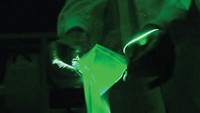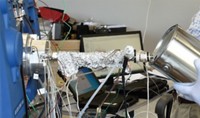Advertisement
Grab your lab coat. Let's get started
Welcome!
Welcome!
Create an account below to get 6 C&EN articles per month, receive newsletters and more - all free.
It seems this is your first time logging in online. Please enter the following information to continue.
As an ACS member you automatically get access to this site. All we need is few more details to create your reading experience.
Not you? Sign in with a different account.
Not you? Sign in with a different account.
ERROR 1
ERROR 1
ERROR 2
ERROR 2
ERROR 2
ERROR 2
ERROR 2
Password and Confirm password must match.
If you have an ACS member number, please enter it here so we can link this account to your membership. (optional)
ERROR 2
ACS values your privacy. By submitting your information, you are gaining access to C&EN and subscribing to our weekly newsletter. We use the information you provide to make your reading experience better, and we will never sell your data to third party members.
Analytical Chemistry
Training of bomb-sniffing dogs could improve with new mass spectrometry tool
A device that detects vapors from explosives could help handlers more accurately evaluate canine performance
by Melissa Pandika
July 20, 2017

Law enforcement has long relied on canines to sniff out dangerous explosives, but large discrepancies exist between individual dogs’ performances that are at least partially attributable to training differences. Now, analytical chemistry may help give the dogs’ powerful sense of smell a keener edge. Researchers have developed a device that could improve dogs’ training by analyzing odors from explosives in real time (Anal. Chem. 2017, DOI: 10.1021/acs.analchem.7b00451).

Handlers typically present bomb-sniffing dogs with training materials containing 2,4,6-trinitrotoluene (TNT), triacetone triperoxide (TATP), and other explosives to teach them to recognize the vapor plumes the materials emit. The handlers then hide the materials and evaluate the dogs’ ability to find them. Problem is, handlers often use multiple training materials during a session, which can lead to cross-contamination of one material with another. Without a way to measure the molecular composition of the vapors coming off the materials, such contamination can go undetected, muddling the results of dogs’ performance evaluations.
To improve the validity of training materials and handlers’ accuracy in assessing canine performance, researchers led by Ta-Hsuan Ong of MIT Lincoln Laboratory developed a real-time mass spectrometer that measures nine compounds found in explosives at parts-per-quadrillion levels, comparable to or better than the detection limits of dogs. But “canines still have a lot of things they’re good at,” Ong says. For instance, they’re more mobile, able to search large or densely crowded areas.
Ong’s team used the device to test a set of training materials for cross-contamination. Four bomb-sniffing dogs completed a training exercise to find various hidden explosives. The researchers then analyzed training samples that the dogs had identified correctly—confirming the presence of explosives in those samples—and incorrectly. Some dogs had alerted their handler to explosives in so-called blanks, training materials that supposedly didn’t contain explosives. But analysis with the device revealed that six of the 68 blanks were contaminated with explosives. The findings suggest that handlers could use the device to determine whether an apparent canine error may have in fact resulted from contamination or other problems.
The device also gives information about how vapors come off of explosive materials, which affects how the dogs smell plumes in the air. To investigate this, the researchers placed a vial of TATP 30 cm away from the device and measured TATP levels over time. The sample produced a signal that spiked every few seconds, indicating filaments of the explosive wafting into the air and passing over the device. If dogs perceive short, periodic bursts of strong scent—rather than a constant, faint one, as some believe—that could mean that a dog struggling to detect an explosive might be having trouble because it may not have encountered a vapor filament yet. Handlers could consider this finding in evaluating a dog’s performance, Ong says.
David Atkinson, chief scientist for explosives detection research at Pacific Northwest National Laboratory, notes that the researchers tested the device on only a few canines and on a narrow range of compounds. Also, the device can’t mimic head-tilting or other behaviors dogs engage in to help them detect odors. Still, it has a comparable level of sensitivity. “It’s a very good start,” Atkinson says. “We could put a number on a dog’s performance and make the training of these dogs a lot easier.” Ong says similar technology could also help better train dogs in narcotics detection or breath analysis for diagnosing disease.





Join the conversation
Contact the reporter
Submit a Letter to the Editor for publication
Engage with us on Twitter